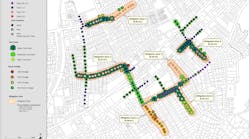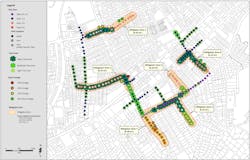Distribution Design Best Practices to Drive System Resiliency, Reliability
All utility companies are faced with government regulators and a customer base that are demanding a more reliable power supply. Many have implemented reliability improvement programs that have taken on many forms. However, the most prevalent are multiyear programs that have been reviewed and approved by regulators through rate cases. Based on experience assisting many investor-owned utilities with their programs, this article will cover some of the basic practices in the approach and implementation of reliability and resiliency improvement programs.
Data Acquisition, Management, and Analytics
The foundation of any good reliability program is accurate data, whether we talk about system performance data (SAIFI, CAIDI, and so forth) or data that overlays annual vegetation management programs into a geographic information system (GIS). In addition, most utilities have regular inspection and maintenance (I&M) programs for feeders, intending to regularly patrol each circuit and identify maintenance needs. These I&M programs would typically occur such that each circuit is patrolled at least once every 3 to 5 years. Maintenance items identified during these circuit inspections would then be categorized into prioritized repair programs. The most critical items would be completed quickly, and other less critical items would be done on a programmatic basis.
We have found that integrating data from multiple sources into a single focal point and reviewing and prioritizing the data by substation and circuit allows a user to come up with the best overall approach to reliability and resiliency. Integrating from multiple platforms into one comprehensive visual representation gives a clear picture of your overall performance from a feeder/substation (exhibit). Using tablets has provided clear, consistent field data collection and allows the user of the data to get a clear and consistent message from our field inspections.
Vegetation Management
For utilities in the eastern United States, vegetation issues are often the leading cause of outages; these include trees and limbs falling on power lines. A thorough and regularly scheduled tree trimming program is essential to minimize outages. We find that a comprehensive review of a vegetation management program to address recurring issues is also beneficial because growth rates differ depending on the type of vegetation, weather impacts, and so on.
Feeder/Storm Hardening
Feeder and storm hardening programs have been initiated and implemented by many utilities. These programs focus on improving circuit resiliency on a programmatic basis, typically focusing on a priority order based on upgrading the worst-performing circuits first. Many utilities will reprioritize the feeders each year based on the most recent feeder reliability data. Hardening programs can take on many forms, but the following summarizes some of the most common focus areas:
- Upgrading pole class and heights
- Improving/repairing guying
- Replacing bare conductor with insulated conductors (that is, tree wire)
- Using more resilient materials such as fiberglass crossarms or even concrete or laminated poles
- Replacing open wire with spacer cable construction
- Using a more compact pole-top construction method
- Lightning arresters/grounding
- Equipment replacement
- Animal guards
- Sectionalizing
While converting overhead circuits to underground can significantly benefit reliability, the higher cost associated with underground construction makes this practice not practical on a wide-scale basis. However, there are cases to be made for selective undergrounding of some extremely critical circuits or portions of circuits.
History has shown that feeders that have undergone storm hardening measures, including many of those outlined above, have fared better in the next wave of severe weather. To minimize the number of customers affected by outages, it makes sense to review proper sectionalizing followed by hardening of the mainline and then hardening of laterals.
Outage Management and Distribution Automation
While integrating I&M programs and feeder hardening programs typically identifies reliability issues from a pole-by-pole perspective, distribution automation (DA) can also have significant positive impacts on customer reliability metrics. DA systems use digital sensors and switches along with control and communications technology to quickly identify a fault location and automatically initiate feeder switching that will limit the outage to the area of the fault between the two closest switching points. These technologies can have a significant impact in limiting the number of customers affected by a fault condition and the duration of the outage.
DA programs can include some or all of the following:
- Fault indicators
- Reclosers
- Smart switches
- Smart relays
Reclosers and smart switches can automatically restore power to those customers not in the fault zone to adjacent circuits, limiting the number of customers impacted by the outage. These systems combined with an automated outage management system allow utilities to dispatch crews quickly and efficiently to the fault area, which also improves restoration time for customers.
Conclusion
Today's customers and the government regulators that represent these customers demand a highly reliable and resilient electrical distribution system. Utilities face a challenging environment because of increasing demands for reliable power, aging infrastructure, and an increase in severe storms and weather conditions that impact the grid.
Our experience has shown that a robust data collection, management, and analysis system and methodology are critical to improving and maintaining electrical distribution reliability metrics. This, combined with a programmatic approach to vegetation management and feeder/storm hardening of infrastructure, can significantly improve the resiliency and reliability of overhead distribution systems.
Once these key pieces of the program are in place, a robust outage management system combined with the implementation of sensors and distributed automation equipment can significantly reduce the impacts of any faults on the system by minimizing the number of affected customers and reducing restoration time.





